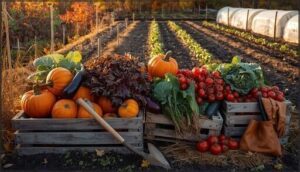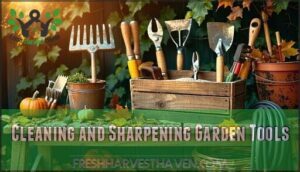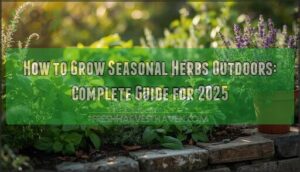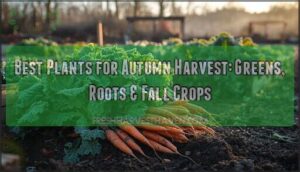This site is supported by our readers. We may earn a commission, at no cost to you, if you purchase through links.
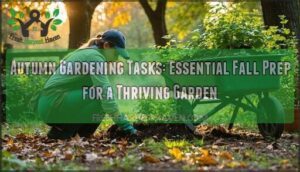 Autumn gardening tasks aren’t just busy work—they’re your garden’s insurance policy for next year’s success.
Autumn gardening tasks aren’t just busy work—they’re your garden’s insurance policy for next year’s success.
You’ll want to focus on soil prep by adding compost and organic matter while the ground’s still workable. Protect tender plants with fleece covers or mulch, and don’t forget to divide overcrowded perennials before they go dormant.
Clean up diseased plant material, but leave some seed heads for wildlife. Store sensitive equipment like irrigation systems before frost hits.
Sharp, clean tools make spring easier too. These fall fundamentals might seem overwhelming, but there’s actually a strategic order that makes everything click into place, following a logical soil prep and using clean tools to ensure a successful garden.
Table Of Contents
- Key Takeaways
- Fall Garden Preparation
- Protecting Plants From Cold
- Plant Maintenance and Pruning
- Wildlife Gardening and Habitat
- Garden Cleanup and Sanitation
- Frequently Asked Questions (FAQs)
- What to do in the garden in fall?
- What is the best plant to grow in autumn?
- What crops do farmers plant in the fall?
- How do you prepare soil for autumn?
- When should I harvest root vegetables?
- How do I winterize my irrigation system?
- What vegetables can I grow indoors?
- Should I fertilize before winter dormancy?
- How do I prepare fruit trees?
- Conclusion
Key Takeaways
- Prepare your soil now – You’ll want to add compost and organic matter to beds while the ground’s still workable, then consider cover crops like winter rye to protect and enrich soil through the cold months.
- Protect plants before frost hits – Use fleece tunnels, mulch tender perennials, and bring sensitive containers indoors to create protective microclimates that’ll keep your plants alive through winter.
- Clean up strategically – Remove diseased plant material to prevent problems next year, but leave some seed heads and untidy areas for wildlife habitat and natural winter protection.
- Maintain tools and equipment – Clean and sharpen your garden tools, drain irrigation systems, and organize supplies in labeled containers so you’re ready to hit the ground running come spring.
Fall Garden Preparation
Fall garden preparation starts with enriching your soil for next year’s growing season.
You’ll want to add compost and aged manure to empty beds, then consider tilling in amendments and planning your crop rotation to keep plants healthy.
Adding Organic Matter
As autumn arrives, you’ll want to boost your soil’s health with organic matter additions.
Rich compost and aged manure work like magic, transforming tired earth into productive garden gold that’ll reward you next spring.
Fall’s gardening magic transforms your tired soil into next season’s treasure chest.
By incorporating organic methods, you can improve soil health benefits and create a thriving garden ecosystem.
Here are three essential organic matter additions:
- Compost Creation – Mix kitchen scraps with fallen leaves for nutrient-rich soil amendments
- Leaf Mulching – Rake and apply fallen leaves directly to garden beds for natural enrichment
- Manure Usage – Incorporate aged manure to improve soil structure and provide steady nutrient release
Tilling and Crop Rotation
Once you’ve enriched your soil with organic matter, it’s time for fall tilling and smart crop rotation planning.
Turn your soil now to incorporate amendments and improve structure for spring planting.
Practice crop rotation strategies by avoiding planting the same plant families in identical spots for three years.
This soil preparation and garden rotation approach prevents disease buildup while maximizing soil health through strategic fall tillage techniques.
Sowing Over-Wintering Green Manures
While temperatures drop, green manures like grazing rye and winter field beans create living blankets that protect your soil from erosion.
These winter cover crops aren’t just garden fillers—they’re nature’s soil conditioners, enriching beds with organic fertilizer while supporting crop rotation plans.
- Grazing rye – Hardy grass that prevents nutrient leaching
- Winter field beans – Nitrogen-fixing legume for spring fertility
- Winter tares – Fast-growing cover that suppresses weeds
Protecting Plants From Cold
As temperatures drop, you’ll need to shield your tender plants from frost and freezing winds that can damage or kill them.
Smart protection methods like fleece tunnels, proper insulation, and strategic mulching will keep your garden thriving through the cold months ahead.
Using Fleece Tunnels and Cloches
Your plants deserve better than just hoping they’ll survive winter’s bite. Fleece tunnels and garden cloches create protective microclimates that boost temperatures by 2-6°F, giving your crops the edge they need.
| Protection Type | Best For | Temperature Boost |
|---|---|---|
| Garden Fleece | Leafy greens, herbs | 2-4°F warmer |
| Glass Cloches | Individual plants | 4-6°F warmer |
| Fleece Tunnels | Row crops, seedlings | 3-5°F warmer |
| Cold Frames | Starting seeds early | 5-8°F warmer |
| Polytunnels | Extended season growing | 6-10°F warmer |
Secure your frost covers with sandbags every 3-4 feet to prevent wind damage and guarantee your winter protection systems last all season. Effective cold weather protection methods can make a significant difference in maintaining healthy plants during harsh winters.
Insulating Tender Container Plants
Your container plants face serious risks when temperatures drop below 50°F.
When temperatures drop below 50°F, your container plants are in real danger.
Citrus winterizing requires moving Mediterranean herbs and trees to sheltered areas like garages. Use container elevation with pot feet to prevent terracotta cracking.
Wrap garden containers with garden bubble wrap for extra garden insulation. Indoor propagation in frost-free greenhouses guarantees tender perennials survive winter’s harsh conditions.
Choosing frost resistant pots can prevent cracking and damage during freezing temperatures.
Storing Ollas and Sensitive Equipment
Winter weather can crack your precious ollas, so bring these clay irrigation vessels indoors before freezing temperatures arrive.
Store them in a garage, basement, or shed where they’ll stay dry and protected. Consider olla winter protection for proper storage.
Don’t forget other sensitive garden accessories like delicate sprinklers, timers, and hose attachments—organize supplies in labeled containers for easy spring retrieval and prevent damage to your precious ollas and other sensitive garden items.
Mulching to Retain Heat
After protecting your sensitive equipment, proper mulching becomes your garden’s thermal blanket.
Apply four inches of mulch materials like leaves or straw after the ground freezes to prevent frost heaving.
This creates a protective microclimate that insulates plant roots and maintains soil temperature.
Your autumn gardening tasks should include mulching for effective winter protection of garden soil.
Plant Maintenance and Pruning
Fall’s the perfect time to give your plants the care they need to survive winter and thrive next spring.
You’ll want to focus on strategic pruning, dividing overgrown perennials, and protecting your garden from harsh weather damage, including harsh weather.
Pruning Perennials for Health
Through careful autumn pruning, you’ll boost your perennials’ health and set them up for vigorous spring growth.
Focus on pruning timing by cutting back disease-prone plants like peonies and lavender after their first frost. This disease prevention strategy removes potential fungal issues while encouraging growth in root systems.
Always sanitize your tools between plants to prevent spreading pathogens. Remember, proper perennial maintenance now provides essential winter protection for next year’s garden success, which is achieved through careful autumn pruning.
Dividing and Propagating Plants
Fall’s perfect for dividing clump-forming perennials like mint and chives.
Division timing matters—work during dormancy for best root stimulation.
Your plant propagation success depends on proper cutting care and technique.
- Water plants 1-2 days before dividing to facilitate easier separation
- Use a long-handled spade to dig complete circles around plant crowns
- Include at least one shoot and established roots in each divided section
Protecting Plants From Erosion
Bare soil becomes vulnerable once winter arrives, losing precious topsoil to harsh weather and runoff.
You’ll want to shield exposed areas using proven soil erosion prevention methods that work like a protective blanket. You can find various erosion control products for different needs.
| Protection Method | Best For |
|---|---|
| Straw mulch | Vegetable beds, annual flower areas |
| Landscape fabric | Slopes, pathways, problem areas |
| Winter cover crops | Large garden sections, unused plots |
| Leaf mulch | Around trees, perennial borders |
| Organic matter layers | Freshly tilled soil, new plantings |
Cover crops like peas and oats act as living shields while adding nutrients. Apply mulch types strategically—straw works great for most areas, while landscape fabric handles steep slopes. This soil protection investment pays dividends come spring.
Trimming Back Marginally Hardy Perennials
Hold off on pruning timing for marginally hardy perennials until spring arrives.
Winter protection comes from leaving stems and foliage intact, which shields crowns from harsh weather.
Spring recovery improves when you wait to trim, as old growth provides insulation.
Disease prevention means removing only damaged material now.
Understanding growth habits helps you make smart autumn gardening decisions for better seasonal plant care.
Wildlife Gardening and Habitat
Fall’s the perfect time to transform your garden into a wildlife haven that’ll buzz with activity all season long.
You’ll create lasting habitats while supporting local ecosystems through simple, rewarding tasks that benefit both your garden and the creatures that call it home, allowing you to create a lasting impact on your local ecosystems.
Creating Wildflower Habitats
Now’s the perfect time to transform empty garden spots into vibrant wildlife gardening havens.
Create pollinator plots by selecting native species seed mixes that’ll bloom throughout next year’s growing seasons.
Choose plants matching your soil conditions and sunlight exposure. Mix flowers with native grasses for natural habitat design that supports local wildlife populations.
Plan for long-term maintenance by minimizing future interventions once established.
Installing Bird Boxes and Feeders
Now’s the time to install bird feeders and garden bird boxes to support wildlife through winter.
Place feeders near windows where you can watch different bird species visit, but keep them far enough to prevent window strikes.
Choose sturdy box designs with proper drainage and ventilation for year-round use.
Winter feeding becomes critical when natural food sources disappear, so maintain clean feeders and fresh water stations.
Attracting birds to your garden creates a lively ecosystem that benefits both wildlife and your outdoor space, and this can be a key part of supporting local biodiversity.
Leaving Untidy Areas for Wildlife
Resist the urge to tidy everything—your garden’s "messy" corners are wildlife goldmines.
Leave leaf piles under shrubs for hibernation areas, keep seed heads standing for winter wildlife food, and stack logs to create habitat.
These untidy spots provide pollinator protection and essential resources.
To further support wildlife, consider leaving leaves and stalks for natural shelters.
Your wildlife gardening efforts turn chaos into thriving garden wildlife habitats.
Protecting Garden Ponds From Debris
Your garden pond needs protection from falling autumn leaves to maintain water quality through winter.
Install pond netting before leaves start dropping – it’s your best defense against debris buildup that can cause algae problems and harm fish.
Stretch the netting tautly across the surface, securing edges with weights or stakes.
This simple step prevents decomposing leaves from releasing harmful compounds into the water, making winterizing ponds much easier and keeping your aquatic ecosystem healthy.
Garden Cleanup and Sanitation
A thorough fall cleanup protects your garden from diseases and pests that can overwinter in plant debris and dirty tools.
You’ll also want to properly store equipment and sanitize your infrastructure to guarantee everything’s ready for next spring’s growing season. Complete concepts and separate lines are key.
Removing Dead Plant Material
After the first hard frost signals summer’s end, you’ll want to clear away dead and diseased plant material from your garden beds.
This fall garden cleanup prevents disease prevention issues and improves pest control by removing hiding spots for unwanted visitors.
Don’t toss everything though – healthy crop debris makes excellent compost management material for next year’s soil health boost.
Sanitizing Garden Infrastructure
Clean infrastructure prevents disease from spreading to next year’s plants.
Mix one part bleach with nine parts water for effective sanitization that kills harmful pathogens lurking on your equipment. Proper fall garden cleanup is essential for maintaining a healthy garden ecosystem.
Essential sanitization tasks include:
- Trellis sanitation – scrub supports with disinfectant solution
- Cage cleaning – remove soil buildup before storage
- Pot sterilization – soak containers for 10-15 minutes
- Tool disinfection – clean blades between diseased plants
- Winterizing infrastructure – sanitize greenhouse benches and irrigation systems
Storing Equipment and Supplies
Before winter hits, proper storage keeps your garden supplies in top shape.
Store trellises, row fabric, and netting in enclosed spaces like sheds to prevent weather damage.
Use labeled containers or bins for easy spring identification, and roll up fabrics neatly to protect materials from rodents with secure storage.
This simple shed maintenance and supply organization saves money and frustration come planting season.
Cleaning and Sharpening Garden Tools
Your tools deserve better than being tossed in a dusty corner. Clean hand tools with soap and store them in sand mixed with vegetable oil to prevent rust.
Drain garden hoses before freezing weather hits, and sanitize sprayers with thorough soap-and-water cleaning.
Sharpen pruner blades, loppers, and shovel edges for next season’s efficiency.
Frequently Asked Questions (FAQs)
What to do in the garden in fall?
As leaves begin to fall, you’ll want to plant cool-season crops, clean up debris, protect tender plants, and prepare soil with compost for next year’s growing season.
What is the best plant to grow in autumn?
Spinach stands out as autumn’s champion crop. You’ll harvest tender leaves in just 40-50 days, and it thrives in cool temperatures that would stress summer plants.
What crops do farmers plant in the fall?
Farmers plant hardy crops like winter wheat, barley, and rye in fall.
You’ll also see cover crops such as clover and winter peas planted to protect soil and add nutrients for spring planting seasons.
How do you prepare soil for autumn?
Soil that’s properly prepared can increase fall crop yields by up to 40%.
You’ll want to add compost and aged manure to empty beds, then test your soil’s pH.
If it’s too acidic, work in some garden lime. Till everything together before planting your autumn vegetables.
When should I harvest root vegetables?
Harvest root vegetables like beets, turnips, and radishes after their first light frost – it actually sweetens them.
You’ll know they’re ready when they’re firm and reach expected size for their variety.
How do I winterize my irrigation system?
Like winterizing a house before a blizzard, you’ll drain hoses and irrigation lines before freezing weather hits.
Turn off water supplies, blow out remaining water with compressed air, and store hoses indoors to prevent cracking.
What vegetables can I grow indoors?
You can grow leafy greens like lettuce, spinach, and Swiss chard indoors year-round. Herbs such as basil, cilantro, and chives thrive on sunny windowsills or under grow lights.
Should I fertilize before winter dormancy?
Don’t put all your eggs in one basket—stop fertilizing now. You’ll encourage tender growth that’ll freeze and damage plants. Instead, let them naturally prepare for winter’s rest.
How do I prepare fruit trees?
Prune your fruit trees by removing dead, damaged, or diseased branches. Clean up fallen fruit and leaves to prevent pests and diseases from overwintering. Apply winter mulch around the base.
Conclusion
Successfully completing these autumn gardening tasks isn’t just about ticking boxes—it’s about setting your garden up for a winter rest it truly deserves.
You’ve invested time in soil preparation, protected vulnerable plants, and created wildlife havens that’ll pay dividends come spring.
Your clean tools and organized storage mean you won’t scramble when planting season arrives.
Most importantly, you’ve given your garden the foundation it needs to emerge stronger and more vibrant next year.
- https://yardandgarden.extension.iastate.edu/how-to/fall-garden-tasks
- https://realselfsufficiency.com/fall-garden-tasks-make-life-easier-next-spring/
- https://lovelygreens.com/fall-gardening-checklist-autumn-gardening-tasks/
- https://morningchores.com/fall-gardening-activities/
- https://atami.com/blog/cultivation/how-to-prepare-your-garden-or-allotment-for-autumn-essential-tasks-planting-and-other-tips

